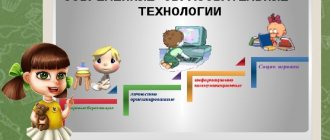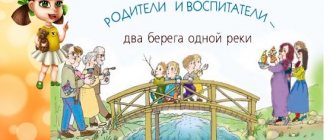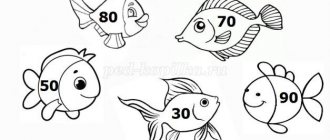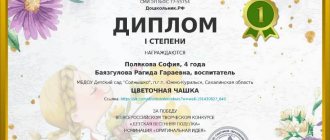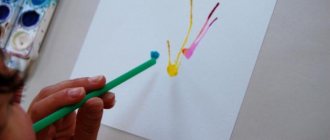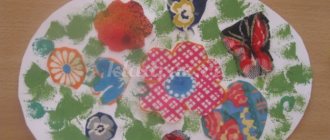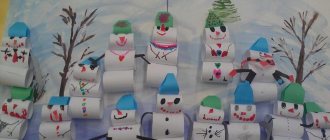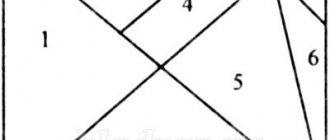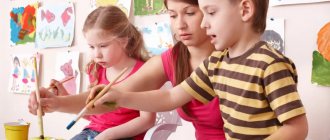Analysis of examples of activities of kindergarten teachers helps improve the education system, helps plan and spend time with children fruitfully and with the greatest benefit. Lessons in kindergarten need to be analyzed systematically, and specially organized open lessons attended by parents, kindergarten teachers, representatives of educational organizations and guests will help summarize teaching experience, receive useful advice, and identify shortcomings.
Why is debriefing done?
You may be interested in: Do you know the meaning of the word “brow”?
Using the example of analyzing the activities of a kindergarten teacher, we can determine:
- Presenter professional training.
- His ability to find an individual approach to a child and work with a group of children.
- Ability to maintain a level of interest in the learning process.
- Identify errors and find ways to correct them.
A good teacher always has something to learn in an open lesson.
In the process of analyzing a lesson for kindergarten teachers, its organization is assessed. It is important that there is enough teaching material for all children. If a drawing lesson using a template is provided, then all children should be provided with paper, pencils or felt-tip pens. Then the stages of logical construction of the lesson are considered.
Psychological mirror
One of the activities of a psychologist in a preschool educational institution is visiting and analyzing teachers’ classes in order to assess the psychological state of children, the absence of overwork, assessing the optimality of selected teaching tools, etc. There are various criteria, but you can use a ready-made scheme for analysis.
A scheme for analyzing a teacher’s occupation as a psychologist was proposed by L. T. Okhitina:
- The presence of comprehensive developmental, training, educational and correctional goals of the lesson.
- To what extent does the content and structure of the lesson meet the principles:
- formation of a motivational basis for an activity (the ability to engage children, the ratio of methods of motivation and coercion to activity);
- individual and differentiated approach;
- the dynamism of children's perception (switching from different types of perceptual activity to others: from auditory to visual, kinesthetic, etc.);
- development of higher mental functions;
- using different types of teaching assistance (imitation, model, verbal instructions, schematic plan, use of symbols);
- using gaming activities as the “outline” of the lesson.
- To what extent is the load distributed?
- on children's memory and their thinking,
- to alternate emotionally rich and interesting, but difficult material; interesting but simple material; uninteresting and simple material; uninteresting and complex material;
- to use reproductive and creative activities?
- What techniques are used to prevent children from becoming tired?
- Which parts of problem-heuristic learning are carried out by the teacher, and which by the children:
- who poses the problem;
- who formulates it;
- who decides?
- The teacher’s ability to combine collective, subgroup, paired and individual forms of work.
- How do adults and peers compare the control, analysis and evaluation of children’s activities? What is the object of assessment by the teacher (knowledge, abilities and skills of children, their behavior, mutual assistance, etc.).
- Features of teacher self-organization:
- preparedness for the lesson (the degree of mastery of the content and psychological purpose of the lesson), internal readiness for the lesson (activity, determination, optimism, resourcefulness);
- pedagogical tact and flexibility of the teacher. work well-being at the beginning of the lesson and during its implementation;
9. Psychological climate in the group:
- How does the teacher support the atmosphere of communication between children;
- type of relationship and communication style.
Analyzing classes in the presence of the entire teaching staff, the educational psychologist performs the functions of psychological education throughout the entire school year.
Other interesting materials:
-Interesting tests for the team;
-Materials for consultations, seminars with teachers.
Views 541, Today 10
Logical stages of lesson construction
You might be interested: Wake is... Origin and meaning of the word
In the introductory part, the kids are explained what and why they will do; in the main part, they begin to do it. Here they need help; it is especially important for the teacher to understand who is having difficulty performing and for what reasons. According to educational standards, development is carried out in five directions: cognitive, speech, social and communicative, artistic and aesthetic, and physical. Tasks are selected according to age.
At the end of the lesson, you need to express approval and support for the children.
How to create a lesson plan
The work of a teacher in a kindergarten is carried out according to a plan, which is drawn up taking into account the characteristics of children at a certain age, daily routine, and dosed load. The educational process should be continuous and systematic, helping the child to actively explore the world around him and taking into account individual characteristics.
The preschool educational institution employee draws up plans for the future and for each day, and based on the lessons conducted, he compiles a report on the work of the teacher in the kindergarten. It consistently tells what work was planned, how it was carried out, what changed in the children’s behavior, and what they learned.
Why are the analysis results needed?
The consequence of a competent analysis of the activities of a kindergarten teacher, for example, is to work on mistakes and identify positive experiences that can be used when planning further work.
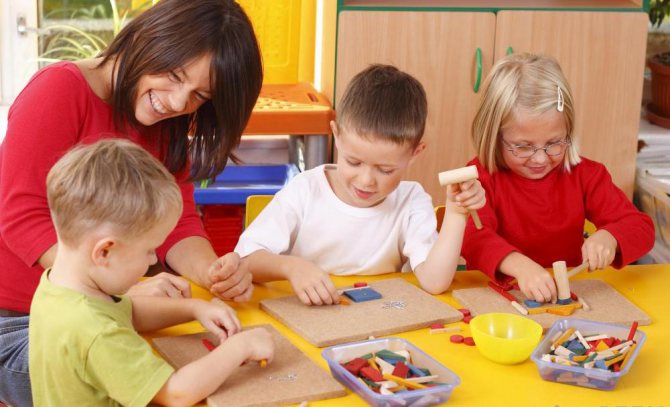
To do this, they carry out operational self-analysis, which allows one to analyze daily observations, and then summarize the results for a certain period and draw useful conclusions. During thematic analysis, a specific area is examined (FISO, FEMP).
The report describes the work done, how it was organized, goals, successes, and evaluates the degree of results achieved in comparison with the expected ones.
Working with parents
In examples of analysis of the activities of a kindergarten teacher, not only work with children, but also with parents is often examined, since they have a greater influence on him in the process of interacting with the child. Often they bring the child to classes late, and at the beginning of the day they do gymnastics with the children. In this case, you need to draw their attention to the importance of arriving on time, talk about the child’s difficulties in performing certain tasks, and about his emotional state.
The report evaluates how visual, creative, verbal, and gaming techniques are combined.
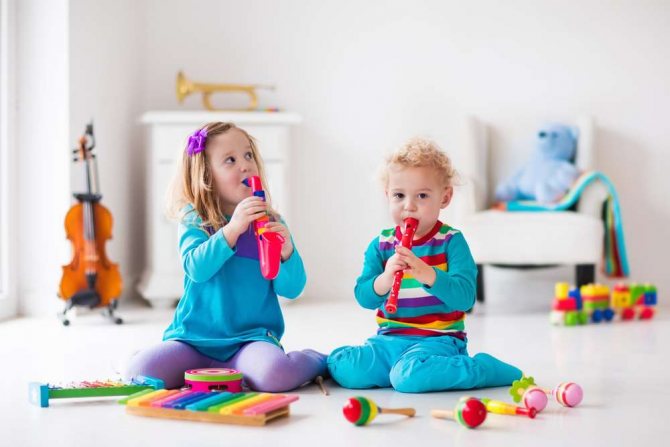
The teacher must devote time to each child during the lesson; his speech and intonation must correspond to the topic. He completes the program items in the allotted time, and if it was not enough, then note for what reasons: as a result of improper planning or disruption of the rhythm of classes.
In accordance with federal requirements, the teacher must conduct an independent analysis of each lesson in order to identify shortcomings, note valuable pedagogical findings, and think about how to help children develop.
Analysis of classes in preschool educational institutions according to the Federal State Educational Standard before. Sample self-analysis of a lesson in a preschool educational institution according to the Federal State Educational Standard before
Kristina Vershinina
Analysis of classes in preschool educational institutions according to the Federal State Educational Standard before. Sample self-analysis of a lesson in a preschool educational institution according to the Federal State Educational Standard before
Analysis of classes in preschool educational institutions according to Federal State Educational Standards for preschool education
General information
1. Topic of the lesson .
2. Date and place of its holding. Who conducts it?
3. Group.
4.Purpose:
• to solve what problems and develop what personality traits of students this lesson ;
•Tasks:
• how the specificity and realism of the goal is realized (from the point of view of sufficient time to complete it, compliance with the children’s preparedness for solving it in previous lessons , the capabilities and abilities of the children);
• how the integration of educational areas is implemented in accordance with the age capabilities and characteristics of students in the classroom .
5. Psychological justification for choosing the form and content of the activity:
• compliance of the lesson with general educational and correctional-developmental goals and objectives, the level of development of students, and their age characteristics;
• implementation of a comprehensive thematic principle (the topic of a particular lesson is chosen in the context of the general topic being studied);
• during the lesson, the joint activity of an adult and children is realized, the main component is interaction.
6. Observing the progress of the lesson
How convincingly, clearly, emotionally were the goals and objectives of the upcoming activity revealed to the students?
How meaningful, interesting and organized was the work?
What knowledge did the students acquire during the lesson :
what social attitudes were formed among the pupils, towards what socially useful
activities prompted their occupation ;
what vital values were formed.
Controllability of the lesson :
• how the opportunity to evaluate intermediate and final results is implemented;
• what conclusions did the students make during the course and at the end of the work;
• what results have been achieved.
How did the lesson the formation of public opinion of the group and individual students on their relationships.
what could be the consequence of this activity for the development of the team, for the formation of its social orientation.
What is its impact on individual pupils:
• emotional and aesthetic responsiveness to beauty in art;
work ethics, artistic activity.
aesthetics of behavior
Methods of work, the nature of relationships, their compliance with educational tasks, age and individual characteristics, the level of development of relationships in the group team.
7. General assessment of the educational event
• To what extent were educational goals and objectives achieved?
• Reasons for successes, failures, mistakes?
• General assessment of the educational value of the work performed.
•Psychological and pedagogical conclusions and suggestions to teachers and students:
• the effectiveness of the lesson in relation to each child;
• analysis of children’s activities (by the teacher)
and
children's self-analysis of their work ;
• reflective moment (the teacher encourages the child to express his attitude to the situation, to his activity).
8. Analysis of the teacher’s activities
Which character traits of the teacher contributed to effective work with students, which, on the contrary, hindered
• the teacher encourages children to show initiative and independence , encourages the manifestation of subjectivity;
• the teacher stimulates and encourages individual achievements of children;
What pedagogical abilities were demonstrated when carrying out effective work with students?
• the teacher takes into account the characteristics of each child (pace of activity, emotional state, level of development of mental processes, temperament)
• the teacher “sees”
each child: helps, stimulates, encourages.
Sample self-analysis of a lesson in a preschool educational institution according to the Federal State Educational Standard for Preschool Education
Goal: To develop children's interest in knowledge about vegetables through the integration of educational areas : cognition, communication, socialization, artistic creativity, health.
Tasks:
— Formation of children’s ideas about vegetables, the place of germination and their preparation for the winter;
-To strengthen children’s ability to describe vegetables according to their characteristic features, according to the diagram;
- Improving the ability to construct your statements grammatically correctly and consistently;
-Expand the active vocabulary, activate the names of vegetables in children’s speech.
-Continue to develop in children the ability to distinguish and name colors, to practice comparing objects by color;
-Encourage children to answer questions by pronouncing words clearly.
-Developing children’s ability to coordinate movements with text, understand and follow verbal instructions;
-Development of visual perception and memory, motor imagination and coordination of movements;
-Development of fine general and fine motor skills of the hands;
-Developing a friendly attitude towards peers;
-Creating a favorable emotional atmosphere and conditions for active play activities of children.
Organizational activities, preparation for class
The lesson was carried out in accordance with the notes. The abstract was compiled independently , in accordance with the objectives of the educational program corresponding to the given age of the children. To implement each task, techniques were selected in an interesting and entertaining form.
At every moment of the lesson there were visual aids that stimulated and activated the children’s mental activity. The manuals are of sufficient size and aesthetically designed. Their placement and use was rational, thoughtful in the learning space and in the lesson .
during the lesson to enhance emotional perception. Organizational reception "Welcome"
in poetic form" was aimed at developing communicative skills, establishing friendly relationships both within the children's team and between guests and children.
The lesson is dynamic , it includes techniques that provide for a quick change of activity. Conversation - sitting on chairs, moving around the group while looking for a way out of a problem situation with a hare - going to the garden, working with dough, developing fine motor skills of the hands - sitting on chairs, search activity - standing, working with cereals “Find a vegetable”
, logorhythmic exercise -
“walking in the garden”
.
A quick rotation of techniques and changes in poses during the lesson made it possible to avoid fatigue in children.
Didactic activities of the teacher
All aspects of the lesson are logical and consistent, subordinated to one topic. the educational areas of Cognition were integrated into the lesson : Reinforced the ability to describe a vegetable according to its characteristic features, according to the diagram; developed the ability to distinguish and name colors;
Communication: children participated in the general conversation, listened without interrupting their peers; activated the children's vocabulary using words - the name of vegetables, practiced coordinating nouns and adjectives; “Socialization”
independently express goodwill and empathy. Artistic creativity: Improved children’s ability to roll plasticine between their palms with straight movements, reinforced pressing techniques, developing fine motor skills of the hands. Physical Culture; developed motor imagination and coordination of movements.
Health: formed children’s ideas about vitamins and their importance. The techniques in the lesson were of a playful nature and were based on playful learning situations.
Using the Vegetable Garden
, helped in an interesting playful way to implement the main educational task - the formation of children’s understanding of vegetables and the place where they grow. My role was limited to learning to give detailed answers. This helped to achieve optimal results.
At every moment of the lesson , I tried to guide the kids to find solutions to the problem, helped them gain new experience, activate independence and maintain a positive emotional attitude.
The creation of search, problem situations intensified the mental and speech activity of children,
The specifics of working with children in the classroom were reflected in a person-centered approach. She encouraged timid children and praised them in order to consolidate their situation of success.
During the lesson , I tried to communicate with the children on the same level, tried to maintain the children’s interest in the lesson throughout the entire time.
The outcome of the lesson was organized in the form of a game problem situation “Guess the treat?”
so that during it you can check the quality of assimilation of the material.
Due to the fact that the children are small and there were many choral responses, I plan to pay special attention to individual responses. It is also necessary to achieve clear pronunciation of words. Work on sound pronunciation, expand active and passive vocabulary. But, despite these difficulties, I believe that all the program tasks I set during the lesson were solved .
Why are open lessons held?
An example of an analysis of classes in kindergarten is the assessment by teachers of other kindergartens of an open lesson.
Evaluation of an open lesson is carried out according to the same scheme as self-analysis. The readiness of the children for the lesson is noted and how the teacher helped them cope with the excitement of the presence of guests, introduced them to the topic of the lesson, formulated the task, and set motivation.

Teachers note how well children are organized, whether teaching methods have been chosen correctly, how to stimulate children’s cognitive activity and retention of attention. Analyzing the course of classes, they note how time was distributed for different types of activities in terms of content and form of perception. During the discussion, guests explore whether the chosen structure of the lesson is justified, how each stage of the lesson is worked out, as well as the smooth transition from one stage to another.
ANALYSIS OF NODS IN ACCORDANCE WITH GEF Topic: “The Magical Land of Vegetables and Fruits”
GCD theme
: “The Magic Land of Vegetables and Fruits” is part of the content of the educational area “Cognitive Development”.
Integration of educational areas
: Cognitive development, Speech development, Social and communicative development,
Goal: formation of sensory standards (development of sensations and perceptions)
Based on the goal of the GCD, I set tasks
:
- Educational:
- Develop the ability to distinguish the color, shape, size of vegetables and fruits, group, compare and generalize according to these characteristics;
- enrich children’s active and passive vocabulary: teach them to understand and use words in speech: “color”, “same”, “different”;
- activate the names of fruits and vegetables, use the words round, red, sour in speech.
- practice counting skills (10-5); find where there is more, less.
2. Developmental:
- correct cognitive processes (attention, memory);
- develop fine motor skills.
- Teach proper speech breathing,
3. Educational:
- develop the ability to play side by side without interfering with each other;
- develop the ability to listen and understand the teacher’s instructions;
- cultivate a desire to help those who find themselves in difficult situations;
The following structure was chosen in the GCD:
1. Organizational point: Involving children in the screensaver on the TV screen.
2. Updating knowledge - solving the problem. Motivation.
3. Statement of the problem. Help the tomato collect vegetables and fruits.
4. Consolidation of new knowledge, repetition.
5. Reflection (result of GCD)
which corresponds to the design model of GCD in accordance with the Federal State Educational Standard.
To successfully solve the identified tasks, I prepared the following demonstration material: a sound letter, a package with a map of the path to completing tasks, a model of a tree-apple tree, a vegetable garden, vegetable caps, musical accompaniment, a round dance game, handouts D.I. “Multi-colored bed”, “Miracle tree”, “Help the hedgehog harvest.” This material helped me reveal the topic in a bright, interesting and accessible way for children.
In preparation for the GCD, preliminary work was carried out: looking at vegetables and fruits, reading the work “Vegetables”, talking about vegetables and fruits.
At the first stage, “Organizational Moment,” I used a team-building game. “The girls and boys in our group are friends”
At the second stage of GCD, to ensure children’s interest in the topic and emotional response to it, I used motivation, created a problematic situation: the appearance of a tomato on the TV screen, “which corresponds to the next task.
At the third stage, “Statement of the problem and solution with children to help the tomato harvest”
What matches the task
At the fourth stage of the GCD, the children and I repeated what the children know about vegetables and fruits, which corresponds to the next task.
At the fifth stage, summing up the lesson, I involved the children in this and asked them to express how we coped with the tasks of the tomato. Was able to create a situation of success. The tomato came out and thanked the children and treated them to fruit.
Application of innovative technologies:
Information learning technology - ICT (information and communication technologies).
Problem-based learning technology
Project-based learning technology
Game-based learning technology
Personally-oriented technologies
TRIZ technology - the theory of solving inventive problems
Research technologies
To satisfy the motor activity of children and preserve their health, I used health-saving technologies. Organized a round dance game “We have a vegetable garden,” breathing exercises “Let’s treat an orange and a strawberry with vitamins,” and constantly monitored the children’s seating.
During the NOD, there was a change in types of activities, a differentiated and individual approach was used.
Types of children's activities
:
(motor, communicative, play, labor, cognitive and research, musical and artistic, productive, reading fiction).
To implement the assigned tasks, I used various principles: (visuality, systematicity, accessibility, consistency, individual approach, development, voice and emotional modulation, psychological comfort).
The following forms of work were used: frontal, individual, group.
— Work in pairs: during the didactic game “Miracle Tree”
— Collective work: looking at the map, did. game "Colorful bed"
— Individual during the game “Miracle Tree”
Methods and techniques.
Visual methods: observation, demonstration of visual aids;
Verbal methods: teacher’s story, conversation.
Game methods: didactic game, imaginary situation in expanded form.
The children were active during the lesson.
Interest remained throughout the entire lesson.
We were attentive except for Alyosha Kh. the boy is absent-minded, his attention is distracted.
The duration of the NOD is 25 minutes, which complies with SanPin standards.
CONCLUSIONS:
— The stated topic was fully consistent with the content of the lesson
Thus, the goal and objectives set within the framework of the NOD were realized. Educational activities contributed to increasing playful motivation for learning, creative development, and cognitive interest. The level of activity of children was at a sufficient level, all children were involved in activities, interest was maintained throughout the entire educational activity. All types of tasks planned with the children were carried out.
Scheme of analysis of a lesson on retelling what was read
For example, if the topic of the lesson is retelling a story, the report notes that the goal is to develop the ability to consistently and expressively repeat what is heard.
To do this, the following skills must be instilled: listen carefully to the text, understand the content, speak loudly and expressively without embarrassment, answer the questions posed in complete sentences.
Such activities play a developing role; they train memory and attention. During such a lesson, children should treat each other with respect, show patience, and provide support, which stimulates social and communicative development.
Map of analysis and observation of GCD productive activities in different age groups
Map of analysis and observation of GCD productive activities in different age groups
Analysis of the OD organization - modeling
| age group (multi-age) | 2 younger | older |
| teacher | Sheredkina O.S. | Sheredkina O.S. |
| subject | "Flower for Mom" | "Vase with a flower" |
| Questions | Value-analytical judgments | |
| Identify and formulate the tasks to be solved in the lesson. | Develop the ability to create objects consisting of 2-3 parts, connecting them by pressing them against each other. To develop children’s ability to convey the features of a flower (stem, leaves, petal). Offer to combine sculpted figures into a collective composition. To develop the ability to sculpt objects in a constructive way. Use plasticine carefully, placing lumps and molded objects on the board. | Strengthen the ability to sculpt objects using sculptural and combined methods. Develop the ability to smooth the surface of a form and make objects stable. Continue to develop the ability to sculpt small parts; using the stack (veins of leaves, patterns on a vase, etc.) Strengthen your neat sculpting skills. |
| Determine the duration of the lesson as a whole and each part. | Lesson duration 15 minutes. Part 1 – preparatory (3-4 minutes), Part 2 – main (8-9 minutes), Part 3 – final (3 minutes). | Lesson duration 25 minutes. Part 1 – preparatory (5 minutes), part 2 – main (15 minutes), part 3 – final (5 minutes). |
| Assess the quality of the visualization, its location and appropriateness of use. | All materials provided and used in the lesson had a bright, aesthetic appearance. They were located at the children's eye level. The teacher used a visual method so that each child could see. | All materials provided and used in the lesson had a bright, aesthetic appearance. They were located at the children's eye level. The teacher used a visual method so that each child could see. |
| List the techniques used by the teacher in the classroom, evaluate the methodological competence of their use. | Artistic expression, examination of a sample, demonstration and explanation, game techniques, analysis of children's work. | Artistic word, teacher's example, explanation, demonstration, questions, individual and group answers, analysis of children's work. |
| Highlight and list the gaming techniques used in the lesson. | Game techniques: “flowers in the meadow”, “butterflies and flowers”. | Game techniques: “flower - seven flowers”, “bees collect nectar”. |
| Determine the level of development of children’s technical skills to work with material. | The level of technical skills when working with plasticine is average. Not all children were able to press the parts together correctly, as a result of which the composition fell apart. | The level of formation is high. Children are good at using this material (plasticine), smoothing, smearing, using a stack, etc. |
| Assess the relationship between the teacher and children, between children. | The relationship between the teacher and children throughout the lesson is positive. The teacher tried to pay attention to each child (she helped, if necessary, suggested). There were no conflict situations between the children. | During the lesson, the children consulted with the teacher and showed initiative in creativity. If a child made an interesting pattern, the teacher drew the attention of all children to this. The guys helped each other if someone didn’t succeed or didn’t have time. There were also no conflict situations between the children. |
| Identify and name integrative areas. | “Cognitive development”, “physical development”, “speech development”, “social and communicative development”. | “Cognitive development”, “physical development”, “speech development”. “Social and communicative development” |
| Lesson rating (from 1 to 5 points) | 3 | 4 |
| Your suggestions for organizing and conducting classes. | A surprise moment at the beginning of the lesson and rewards at the end of the lesson (in the form of sweet prizes or mini gifts). | A surprise moment or a problematic situation (to motivate children emotionally). |
Conclusions:
in the second younger group, the analysis of children's work was carried out by the teacher, aimed at the overall result, and attention was focused on the aesthetics of the work performed.
In the older group, examining images created by children and their own assessment is of particular importance. Unfortunately, not all older children were able to convey the correct proportions. But in general, this lesson showed that the success of learning and developing modeling skills in children is largely due to the creation of playful moments in it (after all, play is the leading activity). The use of a system of gaming techniques was carried out taking into account a number of factors: the nature, place and role of gaming manifestations in children's fine art, age and individual characteristics. Playful teaching methods increased the activity and initiative of children, their response to the images created in modeling, formed the ability to feel and determine their expressiveness, and aroused a desire to improve the image and correct inaccuracies.
Analysis of OA organization - drawing
| Educator | Rogacheva O.E. |
| Age group | average |
| Subject | |
| Questions | Value-analytical judgments |
| Compliance of the content of the lesson with the program of a given age group, time of year, and children’s visual abilities | This activity fully corresponds to the age characteristics of children, the time of year and visual skills. |
| A combination of new and familiar to children | During this lesson, the teacher used game techniques, added new shades of colors familiar to the children, and showed how to mix them to get the desired color. |
| Correctness and accessibility of the teacher’s explanations, ability to demonstrate work techniques | The teacher showed the working techniques step by step, used an outlining gesture, accompanying it with a verbal explanation (the correct location of the drawing on a sheet of paper, the correct position of the brush in the hand, a sample of her drawing). Illustrations for example were accessible, understandable to children and located at the children's eye level. |
| Duration of the lesson by stages and in general, reasons for the delay, if any | The lesson lasted 20 minutes, parts 1, 2 and 3 were distributed correctly. More attention was paid to the practical part, but, unfortunately, not all children managed to finish on time, due to individual characteristics. |
| Children’s behavior in class: organization, discipline, independence, interest, their sense of time, pace of work | Since the teacher introduced a playful technique into the lesson, the children were interested and disciplined. The pace of work was from moderate to slow. |
| General assessment of the lesson, positive aspects and disadvantages, what changes would be advisable to make to the methodology of this lesson | The lesson was interesting and well designed. A surprise moment, a playful technique, the children found it interesting and educational. I don't see the need to make changes to this activity. |
Conclusions:
Children of this age group have well-developed visual skills, but a poorly developed sense of time, so not everyone managed to finish on time. But overall the lesson was very interesting, educational, and new elements were added. Throughout the entire lesson, the teacher maintained the children’s interest, encouraged them, and encouraged them.
Analysis of OD organization – application
| Educator | Kopkova Yu.D. |
| Age group | preparatory |
| Subject | "tea-set" |
| Questions | Value-analytical judgments |
| Compliance of the content of the lesson with the program of a given age group, time of year, and children’s visual abilities | The lesson reflects all the assigned tasks; they correspond to the age of the children and their visual skills. The theme of the lesson may well correspond to any time of year. |
| A combination of new and familiar to children | What was new was contour (silhouette) cutting of an object with a more complex texture; children were familiar with less complex ones (vegetables, fruits). |
| The role of the attendants in preparing the lesson, the combination of the work of the attendants with self-service | Help in preparing for the lesson (distributing mats, scissors, glue, brushes, etc.) to each child, including yourself. After class, help in cleaning tables and washing brushes. |
| Correctness and accessibility of the teacher’s explanations, ability to demonstrate work techniques | Along with visual techniques, the teacher used precise verbal instructions and tasks to independently determine in what way and in what sequence the work should be done. I used the silhouette cutting method, tracing the outline of the object, starting from the part of the object from which to start cutting. |
| Duration of the lesson by stages and in general, reasons for the delay, if any | Lesson duration 30 minutes. Stage 1 - preparatory (organizational moment - 6 minutes), Stage 2 - main (practical part - 15 - 18 minutes), Stage 3 - final (analysis of works, exhibition - 6-7 minutes). |
| Children’s behavior in class: organization, discipline, independence, interest, their sense of time, pace of work | The children worked at a moderate pace, were interested and disciplined. Some showed creative independence in that they wanted to come up with “their own pattern.” But some still needed the help of a teacher. |
| General assessment of the lesson, positive aspects and disadvantages, what changes would be advisable to make to the methodology of this lesson | Overall the lesson went well, the children were interested and positive. The teacher competently distributed the structural parts of the classes (motivation, finger gymnastics, analysis of work). I think that changes in this lesson are unnecessary. |
Conclusions:
summing up the results of this lesson, I concluded that the level of development of visual skills among the majority of the children is high, but 2-3 children have an average level, this is most likely due to the individual characteristics of the children, and not the level of their training and practical skills .
Analysis of an open lesson
When analyzing the lesson plan in kindergarten, it is noted that children learned to break the text into parts, the ability to use the singular, plural, and change words using endings in the necessary cases was consolidated. Thematic pictures were used during the lesson, the structure of the lesson was logically justified. The teacher managed to attract and interest the children and maintain their attention throughout the lesson. The training room was well prepared and ventilated. The children did some exercise during the lesson. The teacher was recommended to more actively encourage individual successes and try to see the characteristics of each child.

Analysis of lessons, the teacher’s thoughtful attitude to the educational process, and attentive attitude towards each child will certainly help make classes useful and interesting.
Source
Analysis of open classes.material (senior group)
Analysis of a lesson on mathematical development
in the older group.
The lesson in the senior group “Firefly” was conducted by Svetlana Valerievna Buryanina.
18 children attended the lesson.
The duration of the lesson is 25 minutes, which complies with SanPiN standards.
Analyzing the lesson, we can say that the assigned tasks were successfully completed. The lesson was structured logically, and the stages of the lesson are interconnected and interdependent, subordinated to a given topic: “Tasks from Smeshariki.” The organizational technique “Greeting” in poetic form was aimed at developing communicative skills, establishing friendly relationships, both within the children's team and between guests and children . The lesson was dynamic and included techniques that included changing activities (at tables, at the blackboard, on the carpet). The children were completely immersed in the atmosphere of entertaining tasks and performed them with particular interest. The methods used were consistent with the material being studied and the ways of organizing children’s activities in accordance with the level of the group.
Game techniques were used: entering an imaginary situation, game motivation, motivation to action, including mental activity, logical techniques: comparison, generalization, classification, inferences. Throughout the lesson, the teacher created problematic situations where the children needed to show their knowledge and skills. Using musical physical activity helped children relax, have fun and relieve stress.
During the lesson, the children were interested, active and attentive, and felt comfortable. During the lesson, the children showed the ability to control their answers and the answers of other children, and help each other with difficulties with answers. Sonya, Arseniy, Nastya F, Anya, Denis, Rita showed particular activity during the lesson. Yasha, Yana and Ulyana experienced difficulty in completing some tasks. Various types of activities contributed to the rapid repetition and consolidation of material. The material for the lesson was selected according to age, corresponded to their psychological characteristics and was rational for solving the set goals and objectives.
I think the session was effective. The selected teaching methods provided motivation for activities, organization of children to achieve assigned tasks, and helped to generalize and consolidate the knowledge gained.
March 2022 Teacher: Elena Vyacheslavovna Tergueva /
Analysis of a literacy preparation lesson
in the older group.
The lesson in the senior group “Firefly” was conducted by the teacher: Svetlana Valerievna Buryanina.
19 children attended the lesson.
The duration of the lesson is 25 minutes, which complies with SanPiN standards.
A game motivation was introduced into the lesson: “Journey through the islands of literacy.” While traveling, the children performed various tasks. This activity created a positive, emotional background for the learning process, increased children’s speech activity and maintained interest throughout the lesson. During the lesson, visual, verbal, and practical techniques were used aimed at using speech and cognitive skills.
Children have developed learning skills. Children easily make contact with the teacher. They know how to hear and listen to the teacher. Changing the type of activity at each stage of the lesson made it possible to prevent fatigue and satiety with one type of activity. To obtain better results in children’s activities, the teacher used a variety of materials: visual aids, didactic and handouts, ICT. At all stages of the lesson, the children’s speech, motor and cognitive activity intensified.
Throughout the lesson, Svetlana Valerievna used the method of control and stimulation in the form of approval and praise.
Analyzing the activities of children in the lesson, I would like to note that they showed cognitive activity, reacted emotionally to methods of activating activities, and used existing knowledge and skills. The children were interested, attentive and organized. Anya, Gleb, Zhenya, Milana, Sasha A, Sonya, Arseny, Denis, Efimy, Nastya F, Rita were very active in the lesson. Yasha, Yana and Ulyana experienced difficulty.
I believe that the chosen form of organizing the educational activities of children was quite effective, dynamic, and the tasks set in the educational activities were completed.
March 2022 Teacher: Elena Vyacheslavovna Tergueva /
